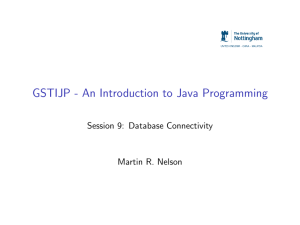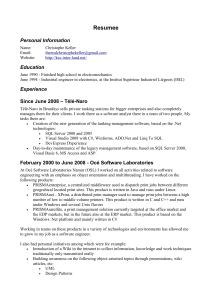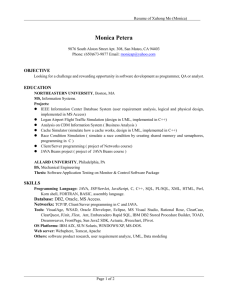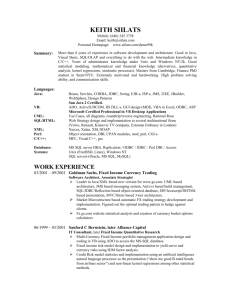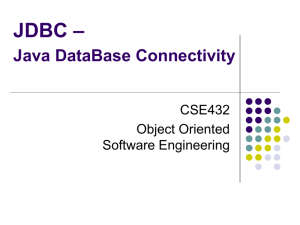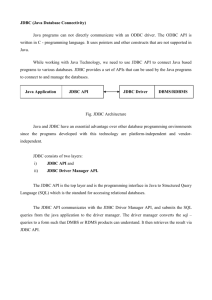JDBC Checker: A Static Analysis Tool for SQL/JDBC Applications
advertisement
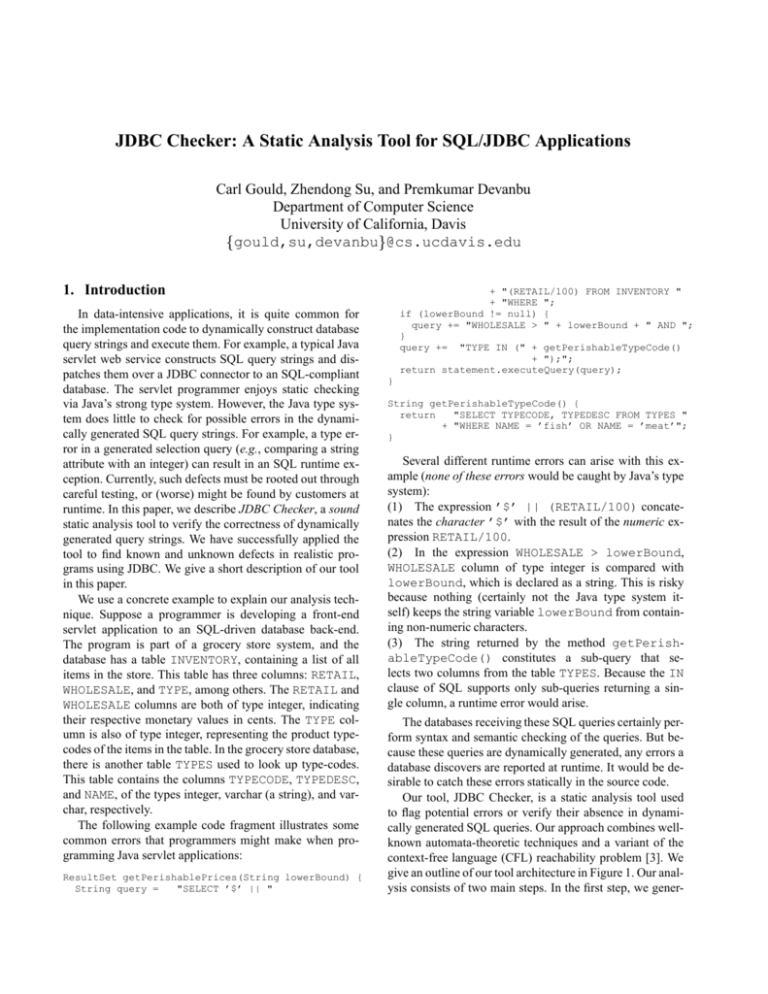
JDBC Checker: A Static Analysis Tool for SQL/JDBC Applications
Carl Gould, Zhendong Su, and Premkumar Devanbu
Department of Computer Science
University of California, Davis
gould,su,devanbu @cs.ucdavis.edu
1. Introduction
In data-intensive applications, it is quite common for
the implementation code to dynamically construct database
query strings and execute them. For example, a typical Java
servlet web service constructs SQL query strings and dispatches them over a JDBC connector to an SQL-compliant
database. The servlet programmer enjoys static checking
via Java’s strong type system. However, the Java type system does little to check for possible errors in the dynamically generated SQL query strings. For example, a type error in a generated selection query (e.g., comparing a string
attribute with an integer) can result in an SQL runtime exception. Currently, such defects must be rooted out through
careful testing, or (worse) might be found by customers at
runtime. In this paper, we describe JDBC Checker, a sound
static analysis tool to verify the correctness of dynamically
generated query strings. We have successfully applied the
tool to find known and unknown defects in realistic programs using JDBC. We give a short description of our tool
in this paper.
We use a concrete example to explain our analysis technique. Suppose a programmer is developing a front-end
servlet application to an SQL-driven database back-end.
The program is part of a grocery store system, and the
database has a table INVENTORY, containing a list of all
items in the store. This table has three columns: RETAIL,
WHOLESALE, and TYPE, among others. The RETAIL and
WHOLESALE columns are both of type integer, indicating
their respective monetary values in cents. The TYPE column is also of type integer, representing the product typecodes of the items in the table. In the grocery store database,
there is another table TYPES used to look up type-codes.
This table contains the columns TYPECODE, TYPEDESC,
and NAME, of the types integer, varchar (a string), and varchar, respectively.
The following example code fragment illustrates some
common errors that programmers might make when programming Java servlet applications:
ResultSet getPerishablePrices(String lowerBound) {
String query =
"SELECT ’$’ || "
+ "(RETAIL/100) FROM INVENTORY "
+ "WHERE ";
if (lowerBound != null) {
query += "WHOLESALE > " + lowerBound + " AND ";
}
query += "TYPE IN (" + getPerishableTypeCode()
+ ");";
return statement.executeQuery(query);
}
String getPerishableTypeCode() {
return
"SELECT TYPECODE, TYPEDESC FROM TYPES "
+ "WHERE NAME = ’fish’ OR NAME = ’meat’";
}
Several different runtime errors can arise with this example (none of these errors would be caught by Java’s type
system):
(1) The expression ’$’ || (RETAIL/100) concatenates the character ’$’ with the result of the numeric expression RETAIL/100.
(2) In the expression WHOLESALE > lowerBound,
WHOLESALE column of type integer is compared with
lowerBound, which is declared as a string. This is risky
because nothing (certainly not the Java type system itself) keeps the string variable lowerBound from containing non-numeric characters.
(3) The string returned by the method getPerishableTypeCode() constitutes a sub-query that selects two columns from the table TYPES. Because the IN
clause of SQL supports only sub-queries returning a single column, a runtime error would arise.
The databases receiving these SQL queries certainly perform syntax and semantic checking of the queries. But because these queries are dynamically generated, any errors a
database discovers are reported at runtime. It would be desirable to catch these errors statically in the source code.
Our tool, JDBC Checker, is a static analysis tool used
to flag potential errors or verify their absence in dynamically generated SQL queries. Our approach combines wellknown automata-theoretic techniques and a variant of the
context-free language (CFL) reachability problem [3]. We
give an outline of our tool architecture in Figure 1. Our analysis consists of two main steps. In the first step, we gener-
Java
Class
Files
TYPE
ERRORS!
Static String
Analysis
Finite
State
Automaton
Type-Checking
Automaton with
Syntax + Type
Type
Environment
Reconstruction
ERRORS!
SQL
Grammar
Database
Schema
Labels
CORRECT
!
Figure 1. Overview of the analysis.
ate a finite state automaton which conservatively approximates the set of SQL strings, using the techniques of [1].
This yields an FSA which captures a set of possible SQL
strings. We then preprocess the automaton to produce a directed graph labeled with the keywords, primitives, and literals of SQL. In the second step, we apply CFL-reachability
to perform semantic checking of the object-programs. One
application of CFL-reachability is used to find typing context and scoping information. This is followed by a second
application of CFL-reachability to perform type checking
on the generated programs, treating SQL’s type system as
a context-free language. Semantic errors, if found, are reported during both phases. It is worth pointing out the main
difference of our analysis from a traditional analysis such as
an SQL type checker. In the standard setting, a single query
is analyzed at execution time, whereas we statically analyze
a potentially infinite set of queries. Our analysis is sound
in the sense it does not miss any errors that we are checking for, and if it does not find any errors, then it is guaranteed that such errors do not occur at runtime. Please see [2]
for a more detailed description of our analysis technique,
experimental results, and a discussion of related work.
2. Experience
We implemented JDBC Checker, a prototype implementation of our algorithm to detect programming errors in
Java/JDBC applications. We have implemented our analysis for the SELECT statement, using a subset of the grammar specified in the SQL-92 standard. Adding support for
other statements or different vendors should be simple. With
the goal of having a sound analysis, we have built a strict semantics into our tool: if a program is deemed type-safe by
our analysis, it should be type-safe on any database system.
Because the semantics of many database systems is not as
strict as the one enforced by our tool, the tool may report an
error which some database systems consider legitimate.
JDBC Checker is implemented in Java and uses the
string analysis in [1] for computing the FSA, which in turn
uses the Soot framework [4] to parse class files and compute
interprocedural control-flow graphs. We have tested our tool
on various code bases, including student team projects from
an undergraduate software engineering class, sample code
from online tutorials available on the web, and code from
other projects made available to us. The tool has found
known and unknown defects in these programs. Our results
indicate that the tool is rather precise, i.e., with low false
positive rates. Because our analysis is sound, if the tool does
not report any error on a program, then we have verified that
the program is type-correct. In addition, although we have
not tuned the performance of our implementation, the analysis is still quite efficient; it was able to analyze each of our
test programs within a matter of minutes.
Demonstration
We will demonstrate the operation of the JDBC Checker
with an example. We will explain and illustrate each step of
the checking process, indicating the finite state automaton
abstraction of the query strings and explaining with an example the use of CFL-reachability in our tool. Finally, we
will illustrate the process of relating a reported error back
to a defect in the original source code.
References
[1] A. Christensen, A. Møller, and M. Schwartzbach. Precise
analysis of string expressions. In Proceedings of the 10th International Static Analysis Symposium, pages 1–18, 2003.
[2] C. Gould, Z. Su, and P. Devanbu. Static checking of dynamically generated queries in database applications. In Proceedings of the International Conference on Software Engineering,
2004. To appear.
[3] T. Reps, S. Horwitz, and M. Sagiv. Precise interprocedural
dataflow analysis via graph reachability. In Proceedings of the
ACM Symposium on Principles of Programming Languages,
pages 49–61, 1995.
[4] R. Vallee-Rai, L. Hendren, V. Sundaresan, P. Lam, E. Gagnon,
and P. Co. Soot–a Java optimization framework. In Proc. IBM
Centre for Advanced Studies Conference, CASCON’99. IBM,
Nov. 1999.
